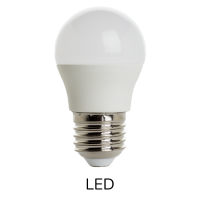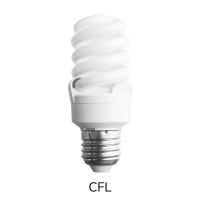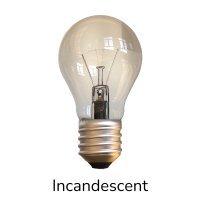Cost Savings
LED light bulbs, in addition to being the most energy-efficient bulbs available, they last the longest and are the least expensive option over the lifetime of the bulb. In fact, if you purchase an LED to replace an incandescent bulb, the initial investment will pay for itself back in less than 1 year. Below is a chart about the annual operating cost and lifespan.
| Lamp Type |
Wattage for 800 Lumens |
Annual Usage Per Lamp* |
Annual Operating Costs** |
Hours (Lifespan) |
Lifetime* |
| Incandescent |
60 W |
55 kWh |
$6.07 |
1,000 |
1.1 years |
| CFL |
14 W |
13 kWh |
$1.41 |
10,000 |
10.9 years |
| LED |
9 W |
8 kWh |
$0.91 |
25,000 |
27.2 years |
* Assumes lamps are used 2.5 hours per day.
** Assumes an electricity price of $0.11/kWh, which is approximately what most Fairfax County residents currently pay. The actual price will depend on several factors, including your electric provider - Dominion Virginia Power or the Northern Virginia Electric Cooperative.
Wattage vs. Lumens
Before LEDs, purchasing light bulbs used to be based on wattage numbers. "Watts” can often be confused with "brightness", but it is actually a measurement of the energy used by the bulb. A 60-watt bulb isn’t necessarily brighter than a 45-watt bulb, it just uses more energy.
When purchasing LED light bulbs, we recommend looking for lumens: more lumens = more light. Use the chart below to make an informed decision that will fit your lighting needs. On the left, find the watts for a standard, incandescent bulb, and what their typical brightness equates to in lumens. For example, if you are looking for an energy-efficient alternative to match the brightness of a 60-watt incandescent light bulb, you should look for an 800 lumen LED light.
| Incandescent Bulb (Watts) |
LED Bulb Brightness (Lumens) |
| 40 |
450 |
| 60 |
800 |
| 75 |
1,100 |
| 100 |
1,600 |
| 150 |
2,600 |
Color Temperature (Kelvin)
Not sure what color temperature means? Light bulbs can come in a range of color temperatures, measured in degrees Kelvin (K). When referring to standard white light bulbs, low temperatures (K measurements), correspond to warm white light, which is typically used in the home. High temperatures correspond to cool white light, sometimes called "daylight", which is often used for workspaces. The chart below can help explain the different color temperatures.




 produce the least amount of heat! Since they’re so energy efficient, if you replace out five incandescent bulbs for LEDs, you could save up to $75 per year!
produce the least amount of heat! Since they’re so energy efficient, if you replace out five incandescent bulbs for LEDs, you could save up to $75 per year! Compact fluorescent light bulbs (CFL) are more energy efficient but harder to dispose of due to the mercury inside of them.
Compact fluorescent light bulbs (CFL) are more energy efficient but harder to dispose of due to the mercury inside of them.  Incandescent light bulbs may be the “traditional” light bulb, but they are the least energy efficient and most expensive to use over their lifetime.
Incandescent light bulbs may be the “traditional” light bulb, but they are the least energy efficient and most expensive to use over their lifetime. 